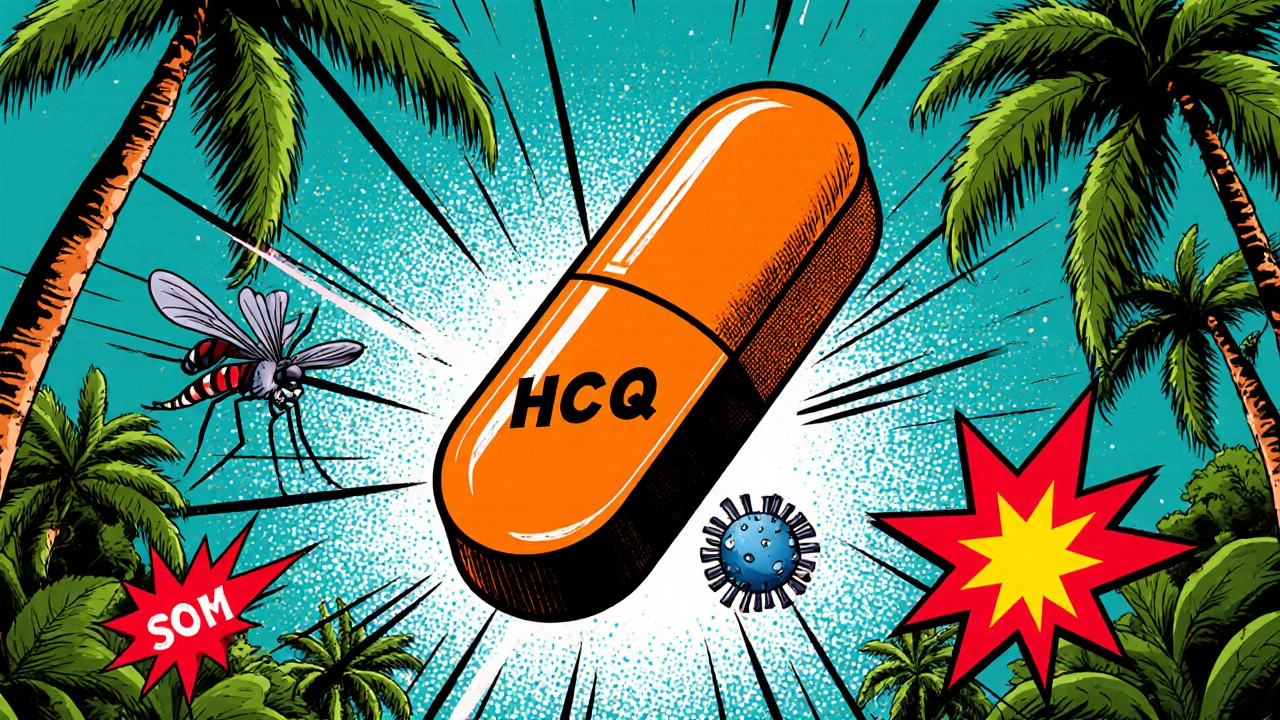Hydroxychloroquine vs Alternatives: Comprehensive Drug Comparison Guide
 Oct, 15 2025
Oct, 15 2025
Medication Selection Guide
This tool helps you understand which medications might be appropriate for your condition based on medical evidence and guidelines. Select your condition and any special considerations to see recommended options.
Select your condition and considerations to see recommendations
When you hear the name hydroxychloroquine, you probably think of malaria, lupus, or the COVID‑19 headlines that dominated the news. But it’s not the only pill that doctors consider for these conditions. This guide lines up hydroxychloroquine against the most common alternatives so you can see where it shines, where it falls short, and what factors matter when choosing a medication.
What makes a drug worth comparing?
Any comparison starts with three questions: What disease are we treating? How safe is the drug for the typical patient? And does the drug actually work better than the options on the table? Answering those questions for hydroxychloroquine and its peers helps you avoid guesswork and focus on the facts that matter to your health.
Hydroxychloroquine - the baseline
Hydroxychloroquine is a synthetic antimalarial that also acts as an immunomodulator. It interferes with parasite digestion of hemoglobin and dampens overactive immune responses, making it useful for malaria prophylaxis, systemic lupus erythematosus, and rheumatoid arthritis. The drug is marketed under brand names such as Plaquenil and is typically taken as a 200mg tablet once or twice daily depending on the condition.
Key attributes:
- Typical oral dose for malaria prophylaxis: 400mg weekly after a loading dose.
- For lupus: 200‑400mg daily, adjusted to blood levels.
- Half‑life: roughly 40‑50 days, meaning it stays in the body for weeks after stopping.
- Common side‑effects: nausea, headache, mild eye irritation; rare but serious retinal toxicity with long‑term use.
Alternative drugs you’ll often hear about
Below are the most frequently discussed alternatives, each with a quick snapshot.
Chloroquine is the older cousin of hydroxychloroquine. It shares the same antimalarial mechanism but is less tolerated, with a higher risk of cardiac arrhythmias.
Azithromycin is a macrolide antibiotic. While not an antimalarial, it was paired with hydroxychloroquine early in the COVID‑19 pandemic for its anti‑inflammatory properties.
Remdesivir is an antiviral originally developed for Ebola. It targets viral RNA polymerase and received emergency use authorization for COVID‑19 treatment.
Doxycycline is a broad‑spectrum tetracycline antibiotic. It is sometimes used for malaria prophylaxis and for bacterial co‑infections in COVID‑19 patients.
Ivermectin is an antiparasitic used for river blindness. Its off‑label use for COVID‑19 sparked controversy due to limited clinical evidence.
Lupus (systemic lupus erythematosus) is an autoimmune disease where the immune system attacks healthy tissue. Patients often need long‑term immunomodulatory drugs like hydroxychloroquine.
Malaria is a mosquito‑borne parasitic infection. Effective prophylaxis and treatment rely on antimalarial drugs, with hydroxychloroquine historically part of the armamentarium.

Side‑by‑side comparison
| Attribute | Hydroxychloroquine | Chloroquine | Azithromycin | Remdesivir | Doxycycline |
|---|---|---|---|---|---|
| Primary Use | Malaria prophylaxis, lupus, rheumatoid arthritis | Malaria treatment, prophylaxis | Bacterial infections, anti‑inflammatory adjunct | COVID‑19 antiviral | Malaria prophylaxis, bacterial infections |
| Mechanism | Interferes with parasite heme detox & immune modulation | Same as hydroxychloroquine, stronger chloroquine‑type binding | Inhibits bacterial protein synthesis (50S ribosomal subunit) | Inhibits viral RNA‑dependent RNA polymerase | Blocks bacterial protein synthesis (30S ribosomal subunit) |
| Typical Adult Dose | 200‑400mg daily (or 400mg weekly for malaria) | 600mg loading, then 500mg daily | 500mg once daily for 3‑5 days | 200mg IV daily for 5‑10 days | 100mg twice daily |
| Half‑life | 40‑50 days | 1‑2 days | 68hours | 1‑2 hours | 18‑22hours |
| Common Side‑effects | Nausea, headache, retinal toxicity (long term) | GI upset, cardiac arrhythmia, tinnitus | Diarrhea, QT prolongation | Elevated liver enzymes, nausea | Photosensitivity, esophageal irritation |
| Pregnancy Safety | Generally considered safe (category B) | Not recommended (category C) | Category B, but monitor QT | Category B, limited data | Category D (risk of teeth discoloration) |
How to decide which drug fits your situation
Pick a medication by weighing three practical factors:
- Indication. If you’re fighting malaria, an antimalarial is mandatory. For lupus, a drug that modulates the immune system (hydroxychloroquine) is preferred over an antibiotic.
- Safety profile. Consider age, pregnancy status, heart health, and kidney function. Hydroxychloroquine’s long half‑life means side‑effects can linger, but its cardiac risk is lower than chloroquine’s.
- Evidence of efficacy. Look for randomized controlled trials or strong observational data. For COVID‑19, remdesivir has FDA approval, while azithromycin’s benefit remains unproven.
When in doubt, discuss the trade‑offs with a healthcare professional who can factor in your medical history.
Pros and cons of hydroxychloroquine
Pros
- Well‑studied for chronic autoimmune diseases; helps reduce flares and steroid use.
- Oral administration, inexpensive generic form.
- Low acute cardiac toxicity compared with chloroquine.
Cons
- Potential retinal damage after years of use; requires yearly eye exams.
- Long half‑life can complicate switching drugs.
- Limited antiviral impact; early COVID‑19 hype has faded.

Quick takeaways
- Hydroxychloroquine shines for lupus and rheumatoid arthritis, less so for acute malaria or viral infections.
- Chloroquine offers faster clearance but higher cardiac risk.
- Azithromycin is an antibiotic, useful only when a bacterial component exists.
- Remdesivir is the only FDA‑approved antiviral for hospitalized COVID‑19 patients.
- Doxycycline provides a cheap malaria prophylaxis option, especially for travel to regions with chloroquine‑resistant strains.
Frequently Asked Questions
Can hydroxychloroquine prevent COVID‑19?
Large, well‑designed trials have shown no meaningful protection against infection or severe disease. Health agencies now advise against using it for COVID‑19 prevention.
Is hydroxychloroquine safe for pregnant women?
Yes, most guidelines place it in category B, meaning animal studies show no risk and limited human data support safety. Still, physicians monitor dosage closely.
How does the retinal toxicity of hydroxychloroquine develop?
The drug accumulates in retinal pigment cells over time. After 5‑7 years of daily use at high doses, microscopic changes can lead to vision loss. Annual eye exams with OCT scans catch early signs.
When would a doctor choose chloroquine over hydroxychloroquine?
Chloroquine is sometimes used where rapid parasite clearance is critical, such as severe malaria in regions where resistance is low. Its shorter half‑life also makes it easier to stop quickly if side‑effects appear.
Do antibiotics like azithromycin help with viral infections?
Antibiotics do not attack viruses. They may be added when a bacterial superinfection is suspected, but the evidence for routine use in viral illnesses like COVID‑19 is weak.
Next steps if you’re considering a change
If you’re already on hydroxychloroquine for lupus and wonder about alternatives, schedule a review with your rheumatologist. Bring a list of any new symptoms-especially visual changes-and ask about blood level monitoring.
Travelers headed to malaria‑endemic regions should verify the local resistance pattern. In many parts of Africa and Asia, chloroquine resistance is high, making doxycycline or artemisinin‑based combos the better choice.
Finally, keep an eye on emerging data. Drug repurposing research moves fast, and the safety landscape can shift with new trial results.
Jeff Hershberger
October 15, 2025 AT 13:17Hydroxychloroquine’s reputation has been twisted into a political rallying cry, but the pharmacology remains stubbornly consistent. Its half‑life drags on for weeks, which means any adverse effect lingers like a bad after‑taste. Compared with chloroquine, the cardiac risk is lower, yet the retinal toxicity still haunts long‑term users. The drug’s immunomodulatory action shines in systemic lupus erythematosus, where it can cut flare frequency dramatically. In rheumatoid arthritis, it offers a modest steroid‑sparing effect that many patients appreciate. For malaria prophylaxis, its efficacy has dwindled in regions with resistant strains, forcing clinicians to reach for doxycycline or artemisinin‑based combos. The table in the guide neatly shows that azithromycin’s anti‑inflammatory promise never translated into solid COVID‑19 data. Remdesivir, though costly, received FDA approval for hospitalized patients, whereas hydroxychloroquine never cleared that hurdle. The eye‑exam requirement every year may seem bureaucratic, but it catches early macular changes before vision is compromised. Dosage flexibility-200 mg twice daily for lupus or a 400 mg weekly load for malaria-makes it adaptable, yet the same flexibility can breed dosing errors in the frail elderly. The drug’s price point is a comforting whisper for patients without insurance, a fact that masks its hidden monitoring costs. In pregnancy, the category‑B classification reassures clinicians, but the data pool remains thin, urging caution. When you weigh efficacy against safety, hydroxychloroquine occupies a narrow middle ground: not the strongest antiviral, not the most potent antimalarial, but a well‑tolerated chronic immunomodulator for select autoimmune conditions. The guide’s “pros and cons” list captures this nuance without fanfare. Ultimately, the decision hinges on individual disease pathology, comorbidities, and a physician’s willingness to monitor retinal health diligently.
Jesse Najarro
October 16, 2025 AT 17:04Nice breakdown of the key trade‑offs, especially the safety bits that many people gloss over. It’s helpful to see the half‑life comparison laid out side by side so you can weigh how long the drug sticks around. If you’re on lupus meds, this guide gives you solid talking points for your next doc visit.
Dan Dawson
October 17, 2025 AT 20:51Hydroxychloroquine's long half‑life can be a pain for travelers.
Lawrence Jones II
October 19, 2025 AT 00:37From a pharmacokinetic standpoint, the drug’s volume of distribution (Vd) is extensive, translating to tissue sequestration that complicates dose‑adjustment algorithms 🚀. The QTc prolongation risk, albeit modest, still warrants ECG monitoring in polypharmacy scenarios 🩺. Ultimately, its therapeutic index sits comfortably between a narrow window of efficacy and toxicity.
Robert Frith
October 20, 2025 AT 04:24Yo, this drug is wut they call the "Swiss army knife" of meds, definatly worth a second look! But if you ignore the eye test, you might end up blind as a bat, mate.
Brad Tollefson
October 21, 2025 AT 08:11The pharmacological profile of hydroxychloroquine is well‑documented, and its immunomodulatory effects are reproducible in clinical trials. Make sure you follow the schedule definatly. Nevertheless, vigilant monitoring for retinal changes remains essential, even though the risk is relatively low. Patients should also be aware that dosage errors can occur, particularly with weekly loading regimens, so clear instructions are a must.
Paul van de Runstraat
October 22, 2025 AT 11:57Oh sure, because nothing says "cutting‑edge therapy" like a drug that was invented in the 1950s and still needs yearly eye exams. But hey, at least it doesn’t demand a fancy IV drip like remdesivir.
ANTHONY COOK
October 23, 2025 AT 15:44Hydroxychloroquine? Yeah, it’s the OG “miracle cure” that got hijacked by hype‑machines 😒. If you’re not careful, you’ll end up paying for a pricey eye doc while the virus just does its thing 😂.
Sarah Aderholdt
October 24, 2025 AT 19:31Balancing efficacy and safety is a moral calculus, especially when chronic medication shapes quality of life. Choose wisely, and let evidence be your compass.
Phoebe Chico
October 25, 2025 AT 23:17Wow, that guide really paints a vivid picture of the drug landscape! 🌈 I love how it breaks down the pros and cons without drowning you in jargon. It’s like a friendly map for anyone navigating treatment options.
Larry Douglas
October 27, 2025 AT 02:04From a regulatory perspective, hydroxychloroquine has retained a category‑B classification for pregnancy, reflecting a limited but reassuring dataset in animal models. Its pharmacodynamics involve lysosomal pH modulation, which underpins its immunosuppressive properties. Clinical guidelines continue to endorse it as a first‑line agent for systemic lupus erythematosus, whereas its role in acute malaria prophylaxis has been largely supplanted by newer agents due to emerging resistance patterns. Consequently, prescribers must weigh historic efficacy against contemporary resistance data when selecting an antimalarial regimen.
Michael Stevens
October 28, 2025 AT 05:51Great summary, Larry! It’s helpful to see the regulatory nuances laid out clearly. This kind of info really empowers patients to have informed conversations with their doctors.
Ann Campanella
October 29, 2025 AT 09:37This guide is overhyped and way too long.